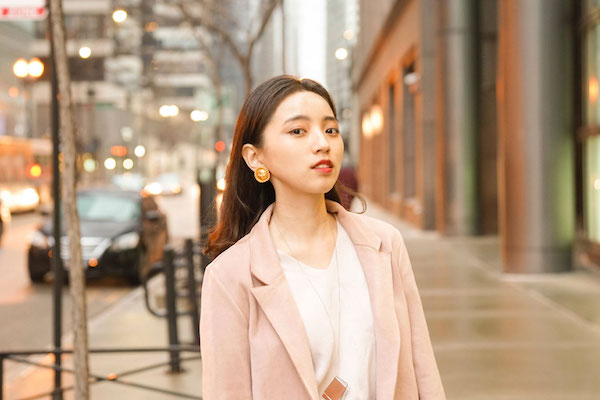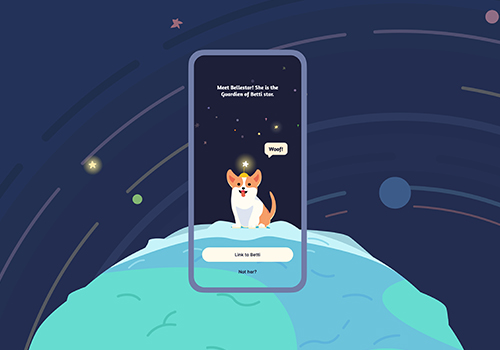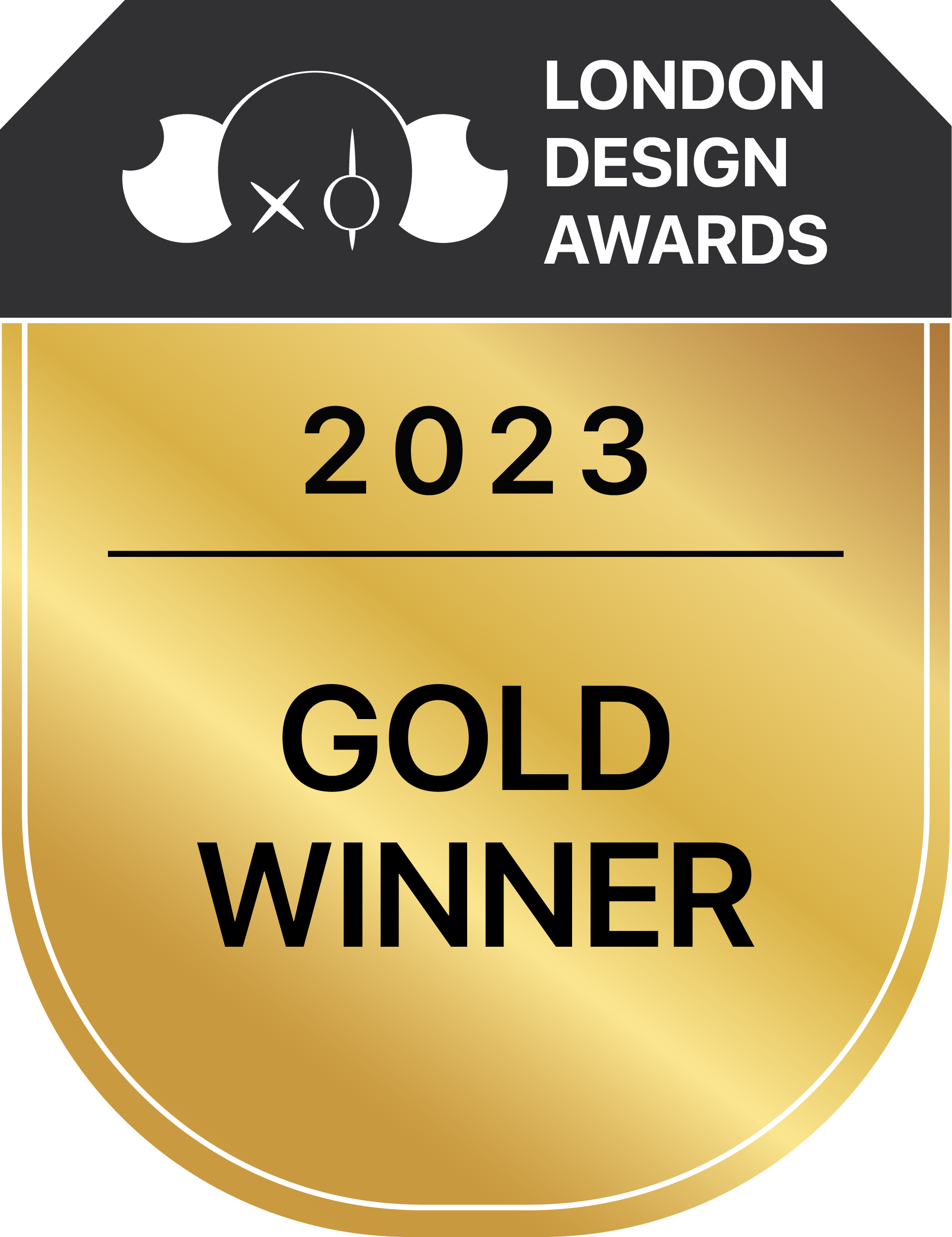
Shuyi Liu
1. Please give us a brief bio of yourself and your design background.
My name is Shuyi Liu. I'm an experienced designer specializing in service experience design, with a profound interest in human behavior and social interaction. My educational background includes degrees in communication engineering and design, graduated from Beijing University of Posts and Telecommunications and the Illinois Institute of Technology, striving to seamlessly integrate human well-being with innovative design. My work is deeply rooted in empathy, aiming to address and solve the emotional and practical challenges faced by diverse social groups. I have been actively involved in projects like creating therapeutic board games for urban dwellers and developing journaling apps for pet owners coping with loss. My designs, recognized internationally, have been awarded multiple design awards. These accolades reflect my commitment to enhancing human well-being through design and my continuous endeavor to push the boundaries of what's possible in service experience design.
2. What made you become/why did you choose to become a designer/artist?
I chose to become a designer because I've always been captivated by the power of visual and user-centered design to create meaningful and impactful experiences. From an early age, I found joy in solving problems through creativity and aesthetics. I believe that design has the potential to improve people's lives, enhance usability, and communicate messages effectively. It's this belief in the transformative power of design that motivated me to pursue a career in this field.
3. Tell us more about your agency/company, job profile, and what you do.
I bring nearly five years of professional experience to my role at a global design and innovation consultancy. Our client portfolio is diverse, encompassing leading tech giants like Google, Meta, and Salesforce, as well as various non-governmental organizations committed to societal betterment.
In my current role, I wear dual hats, blending my skills across consulting projects and our in-house product team. This hybrid experience allows me to navigate the complexities of large-scale consulting projects, where I provide bespoke design solutions to our business clients, and to contribute to our internal product development focused on financial well-being experiences. This unique mix of external and internal roles enables me to maintain a broad perspective while deeply engaging with specific product development.
At the core of my work is a commitment to social and human well-being. Whether I'm consulting for a corporate client or developing products in-house, my philosophy is to design solutions that are not only innovative and efficient but also empathetically aligned with the end-users' well-being. This principle guides my approach to every project, ensuring that our outputs are not just commercially successful, but also socially responsible and beneficial.
4. What does “design” mean to you?
Design, to me, is the art and science of crafting purposeful and aesthetically pleasing solutions to real-world problems. It's about finding the delicate balance between form and function, where every element serves a specific purpose while also contributing to a harmonious whole. Design extends beyond aesthetics; it encompasses user experience, usability, and the seamless integration of technology into our lives. Ultimately, design is a powerful tool for communication, problem-solving, and making the complex simple and beautiful. It's about creating solutions that resonate with people, enhance their lives, and leave a lasting positive impact.
5. What’s your favorite kind of design and why?
My favorite kind of design is where user experience (UX) intersects with social well-being, particularly in the realm of designing for happiness and emotional well-being. I am passionate about this because it allows me to apply my expertise in a way that directly impacts people's lives positively.
In this domain, the design transcends mere functionality and aesthetics; it becomes a tool to enhance the quality of life, foster positive emotional experiences, and support mental health. By focusing on UX in the context of social well-being, I can create solutions that not only meet users' practical needs but also resonate with them on a deeper emotional level. This fusion of UX with a focus on happiness and well-being is immensely fulfilling as it aligns with my philosophy of leveraging design as a force for good in society.
6. To you, what makes a “good” design?
A 'good' design, from my perspective, especially in the context of UX and social well-being, is one that achieves a harmonious balance between functionality, emotional resonance, and societal impact. It should not only be intuitive and user-friendly, facilitating ease of use and accessibility, but also emotionally engaging, creating a positive and meaningful experience for the user.
Furthermore, good design should embody empathetic principles, taking into account the diverse needs and challenges of its users, and striving to improve their quality of life. It's about designing with a purpose beyond aesthetics or technical prowess, focusing on creating solutions that contribute to happiness and well-being, and ultimately, making a positive difference in society.
7. How did you come up with the idea for your award-winning design?
The idea for the award-winning Stardust Weaver app originated from a deep understanding of the emotional impact of losing a beloved pet. As a designer, I was inspired by the profound bond that people share with their animal companions and the unique grief experienced when they pass away. I recognized that existing resources for coping with pet loss were limited and often failed to address the emotional needs of individuals effectively.
My inspiration came from a desire to bridge this gap and create a meaningful solution. I drew upon my background in design and empathy for people going through this challenging experience to envision an app that could offer comprehensive emotional support, guidance, and a sense of connection.
The concept of the app was to use innovative design aesthetics, metaphorical narratives, and AI technology to create an immersive and empathetic platform. By linking the souls of lost pets to stars in the sky, we could provide users with a unique way to remember and process their grief. The combination of personalized journaling plans, research-based content, and a supportive community made the idea even more compelling.
In essence, the idea for Stardust Weaver was born out of a desire to harness the power of design to address a real and often overlooked emotional need compassionately and innovatively.
8. What was your main source of inspiration for this design?
The primary source of inspiration for the Stardust Weaver app design was the profound emotional connection that people share with their pets. Pets often become cherished family members, and the loss of a pet can be a deeply emotional and isolating experience. I was inspired to create a design that could provide solace, support, and a sense of connection to individuals grieving the loss of their animal companions.
Additionally, I drew inspiration from the fields of psychology, sociology, and service design, which informed the framework for understanding the emotional challenges associated with pet loss. These disciplines helped shape the design by offering insights into the role of social support networks, emotional processing, and community in the context of grief.
The concept of linking lost pets to stars in the sky through metaphorical narratives also served as a powerful source of inspiration. It added a unique and emotionally resonant element to the design, creating a sense of continuity and connection between users and their departed pets.
9. Do you think your country and its cultural heritage has an impact on your design process?
Coming from China, my country's rich cultural heritage profoundly influences my design process, particularly in how Eastern culture values harmony, balance, and mindfulness. These principles are deeply embedded in my approach to design, especially in projects like AirSphere.
In Chinese culture, there is a strong emphasis on achieving balance and harmony, not just within oneself but also in one
10. Congratulations! As the winner of the London Design Awards, what does it mean to you and your company and team to receive this award distinction?
Winning the London Design Awards was an immensely gratifying achievement for my colleague and me. It represented not just a recognition of our design skills and creativity, but also an affirmation of our commitment to creating designs that positively impact well-being.
Receiving this award brought a sense of validation and encouragement that the principles we believe in
11. Can you explain a bit about the winning work you entered into the London Design Awards, and why you chose to enter this project?
The winning work that I entered into the London Design Awards is the "Stardust Weaver" app. I chose to enter this project because it represents a unique and innovative approach to addressing a deeply emotional and often underserved aspect of the human experience
12. What were the main challenges you faced during the design process, and how did you overcome them?
Emotional sensitivity. Dealing with pet loss is an emotionally sensitive subject, and it was crucial to create a design that was respectful and empathetic. To overcome this challenge, I conducted extensive research into grief counseling, psychology, and pet-owner relationships to ensure that the app's content and interactions were supportive and sensitive to users' emotional states.
Balancing complexity. Creating a comprehensive app that addressed the diverse needs of users grieving the loss of pets required careful balance. I needed to provide a range of features and content while maintaining a simple and user-friendly interface. User testing and feedback were essential in refining this balance.
Innovation in emotional support. Finding innovative ways to provide emotional support and healing was a central challenge. To address this, I explored various creative and metaphorical narratives, such as linking lost pets to stars, to provide users with a unique and engaging emotional experience.
Accessibility and inclusivity. Ensuring that the app was accessible and inclusive for users with diverse needs, including those with disabilities, was a priority. This involved considerations like contrast for readability, adaptable font sizes, and voice input support. Overcoming this challenge required close collaboration with accessibility experts.
13. How do you think winning this award will impact your future as a designer?
Winning this award is a significant milestone that I believe will have a profound impact on my future as a designer. Firstly, it serves as a strong validation of my design philosophy and approach, particularly my focus on creating solutions that enhance well-being and address social issues. This recognition will undoubtedly bolster my confidence in pursuing ambitious, meaningful projects that push the boundaries of conventional design.
Furthermore, the award provides an elevated platform for visibility within the design community and beyond. It opens up new opportunities for collaboration, networking, and exposure to a wider array of projects and clients who value innovative and socially impactful design. This expanded network and visibility will be instrumental in fostering partnerships that align with my vision and ethos.
Additionally, the award is an inspiration to continue growing and evolving as a designer. It motivates me to keep exploring new ideas, techniques, and methodologies, constantly seeking ways to integrate empathetic and user-centered design in addressing complex challenges.
Winning the London Design Awards is not just an accolade for past achievements but a catalyst for future growth, exploration, and impact in the design world.
14. What are your top three (3) favorite things about the design industry?
My top three favorite aspects of the design industry are:
Innovation and creativity: The design industry is a vibrant space of constant innovation. It encourages creative problem-solving, allowing designers like myself to think outside the box and develop unique solutions to a wide range of challenges. This constant push for innovation keeps the field dynamic and exciting.
Impact on society: Design has the power to significantly impact society and improve lives. Whether it
15. What sets your design apart from others in the same category?
What distinguishes my design work from others in the same category is a blend of deep empathy, innovative integration of wellness practices, and a keen focus on user engagement. At the heart of my design philosophy is a profound understanding of the user
16. Where do you see the evolution of design industry going over the next 5-10 years?
In the next 5-10 years, I envision the design industry, particularly from a UX and social well-being perspective, evolving towards a more holistic and human-centric approach. There will be an increased emphasis on designing experiences that not only meet functional needs but also contribute positively to emotional and mental health. With growing awareness of the impact of design on well-being, I anticipate a surge in solutions that are empathetically crafted, prioritizing user happiness and societal benefit. This shift will likely be supported by advancements in technology, allowing for more personalized and adaptive design solutions that can cater to individual well-being needs more effectively. Overall, the future of design seems poised to become more intertwined with enhancing the quality of human life and fostering a more empathetic and socially responsible design ethos.
17. What advice do you have for aspiring designers who want to create award-winning designs?
For aspiring designers aiming to create award-winning designs, I advise cultivating a deep understanding of your users and a strong commitment to your design ethos. Success in design is not just about technical skill or aesthetic appeal; it's about how well you connect with and address the needs and emotions of your audience. Start by developing a profound empathy for your users, and understanding their challenges, desires, and behaviors. This insight is invaluable in guiding your design process and ensuring that your solutions are innovative but also relevant and impactful.
Another key aspect is to stay true to your unique design philosophy. Having a distinct voice and perspective can set you apart in a field as diverse as design. Embrace your creativity, be bold in your ideas, and don
18. What resources would you recommend to someone who wants to improve their skills in the design industry?
To enhance skills in the design industry, a combination of continuous learning, practice, and exposure to diverse perspectives is key.
Firstly, educational resources are crucial. Online platforms like Coursera, Udemy, and LinkedIn Learning offer a wide range of courses covering various aspects of design, from basic principles to advanced techniques. Additionally, attending workshops and webinars hosted by industry experts can provide practical insights and up-to-date knowledge.
Networking and community engagement are equally important. Joining design communities, both online and offline, like Behance, Dribble, or local design meetups, can provide opportunities for collaboration, feedback, and learning from peers.
Lastly, practice is essential. Engaging in personal projects or freelance work, and seeking constructive feedback can significantly improve your skills. Remember, in the design industry, learning is an ongoing process, and staying curious and open to new experiences is vital for growth.
19. Tell us something you have never told anyone else.
Reflecting on my design path, there's an aspect I've rarely shared, which is the role of introspection in my journey. Early in my career, I realized that understanding myself
20. Who has inspired you in your life and why?
The creator of Bauhaus, L
21. What is your key to success? Any parting words of wisdom?
My key to success in design has been a steadfast commitment to empathy and continuous learning. Empathy, in understanding and addressing the needs and experiences of users, has always been the cornerstone of my design process. It's about seeing design through the lens of those who will interact with your creation, ensuring it resonates with them not just functionally but also emotionally.
Continuous learning is equally crucial. The design industry is dynamic, with evolving trends and technologies. Staying informed, adaptable, and open to new ideas has been instrumental in keeping my work relevant and impactful.
As parting words of wisdom for fellow designers: always remember that great design is not just about aesthetics or utility, but about creating meaningful experiences. Stay curious, be empathetic, and never stop learning. Your unique perspective is your greatest asset; nurture it and let it guide your creative journey.
22. Do you have anything else you would like to add to the interview?
I would like to add that the journey in design is as rewarding as it is challenging. Each project is an opportunity to not just solve a problem, but to touch lives and make a difference. As designers, we have the unique privilege and responsibility to shape the experiences of those around us. I encourage fellow designers to embrace this role with passion and purpose.
Also, I want to emphasize the importance of collaboration and community in our field. The best designs often come from diverse teams where different perspectives and skills converge. Engaging with the design community, sharing knowledge, and learning from others is vital for personal growth and the advancement of our industry.
Lastly, to those just starting or facing obstacles, remember that every challenge is a stepping stone to growth. Stay resilient, stay inspired, and let your passion for design be the light that guides you through your creative journey.

